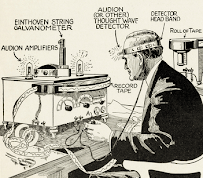 |
| mountain top thought transmitter interior art by Frank R. Paul |
Masters of the Machines. After the discovery of telepathy, Harry Maxwell, a professor of psychology and an inventor, soon constructs a thought transmitter (see the image to the right) and deploys it against the Evil™ Masters of the Machines who "control the means of production and distribution". In analogy to a radio transmitter that broadcasts radio frequency light waves, Maxwell's thought transmitter broadcasts "thought vibrations" and it functions as a "central brain" for all the people of planet Earth, liberating them from the Evil™ "tentacles of materialism".
 |
| Figure 0. Text from page 15 of "The Brain of the Planet". |
Technology-Assisted Telepathy. When the thought transmitter is first activated, thousands of the most extreme radicals and conservatives around the world quickly die because their minds are not compatible with the new regime of thought being imposed by Maxwell. Then Maxwell begins to gradually increase the intensity of his well-intentioned thoughts that are being mechanically broadcast to the people of the world (see Figure 0, above).
 |
| the power of positive thinking |
I suspect that Mary Wright was inspired by the "new thought" movement to imagine a mechanical "thought transmitter" that could put on display Atkinson's "new thought" beliefs inside a science fiction story.
 |
| Figure 1. text from page 19 of "The Brain of the Planet" |
By 1970, under a world government, a Golden Age is achieved and Maxwell destroys the thought transmitter; it is no longer needed.
 |
| Gernsback thought detector |
 |
| into the future |
It is interesting to ponder the origins of Mary Wright's interest in telepathy and also Hugo Gernsback's willingness to publish "The Brain of the Planet". In Gernsback's novel Ralph 124C41+ (A Romance of the Year 2660), he included the idea of a "menograph", a device that could convert thoughts into a printed form of communication that could then be read by others. The device required electrodes placed on the temples to pick up a person's thoughts. Published in book form in 1924 and republished in Amazing Stories Quarterly, in 1929, it seems possible that Mary Wright was aware of Gernsback's novel about future times.
E. E. "Doc" Smith published his novel Skylark Three in 1930 and his story also featured technology-assisted communication between brains.
 |
| cover art by John Solie |
Here is how Smith described the power of a futuristic education device that could transfer thoughts between the alien Orlon and the human crew of Skylark Three: "from his mind into theirs there flowed smoothly a mighty stream of comprehension". This was some form of technology-assisted telepathy which required the use of special headsets worn by the learners.
I conclude that by the late 1920s, science fiction fans and story tellers were probably quite comfortable with the idea of technology-assisted telepathy. Mary Wright also seemed to take seriously the idea that humans might have a form of telepathic communication that can function without the aid of any mechanical amplifying device.
 |
| image source |
Why were so many science fiction story tellers so eager to invent stories about telepathy? The history of psychology as a science of the mind includes people such as William James who treated the possible existence of human telepaths as a worthy topic for scientific investigation. Among some psychologists, telepathy seemed more likely than the idea that people could obtain information from past lives by reincarnation or communication with the dead.
When I was about 12 years old, I broke my foot and my sister, who was about 150 miles away, felt that something bad had happened to me. Similarly, in 1893, Hans Berger fell off a horse and his sister had a bad feeling about her brother. |
| Figure 2. image source |
Asimov did not stop at telepathic "mind reading" by humans; he also wrote stories about telepathic robots (see Daneel). Asimov also suggested that powerful telepaths could use their mental powers to "reach" into another persons brain and exert "mind control" (see the Mule).
I've previously mentioned "The Tissue Culture King" by Julian Huxley (1927). Some people have traced the idea of a "tin foil hat" (to protect against telepathic thought control, see Figure 2, above) back to Huxley's story. Sadly, most scientists can't imagine how the jumble of weak electrical signals emitted by a brain could allow for "mind reading".What was the general academic environment in the late 1800s when the physician-scientist Berger seriously considered the possibility of telepathic communication between people? In 1884, William James became one of the founding members of the American Society for Psychical Research. It was not unusual for scientists to be interested in the possibility of some as-yet-undiscovered way to send telepathic signals between people. Even in the 1900s, Joseph Rhine became famous for his claims about telepathy. Sadly, we got the book Extrasensory Perception in 1934, not the proof of telepathy that Mary Write envisioned for 1935.
Related Reading: "The Machine Stops"Also: eloptic energy
Next: a telekinetic experiment
 |
| visit the Gallery of Book and Magazine Covers |




No comments:
Post a Comment